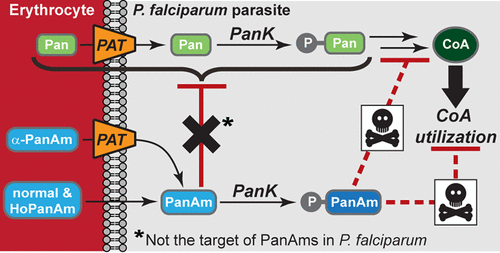当前位置:
X-MOL 学术
›
ACS Infect. Dis.
›
论文详情
Our official English website, www.x-mol.net, welcomes your feedback! (Note: you will need to create a separate account there.)
Antiplasmodial Mode of Action of Pantothenamides: Pantothenate Kinase Serves as a Metabolic Activator Not as a Target
ACS Infectious Diseases ( IF 5.3 ) Pub Date : 2017-05-04 00:00:00 , DOI: 10.1021/acsinfecdis.7b00024 Marianne de Villiers 1 , Christina Spry , Cristiano J. Macuamule 1 , Leanne Barnard 1 , Gordon Wells 1 , Kevin J. Saliba , Erick Strauss 1
ACS Infectious Diseases ( IF 5.3 ) Pub Date : 2017-05-04 00:00:00 , DOI: 10.1021/acsinfecdis.7b00024 Marianne de Villiers 1 , Christina Spry , Cristiano J. Macuamule 1 , Leanne Barnard 1 , Gordon Wells 1 , Kevin J. Saliba , Erick Strauss 1
Affiliation

|
N-Substituted pantothenamides (PanAms) are pantothenate analogues with up to nanomolar potency against blood-stage Plasmodium falciparum (the most virulent species responsible for malaria). Although these compounds are known to target coenzyme A (CoA) biosynthesis and/or utilization, their exact mode of action (MoA) is still unknown. Importantly, PanAms that retain the natural β-alanine moiety are more potent than other variants, consistent with the involvement of processes that are selective for pantothenate (the precursor of CoA) or its derivatives. The transport of pantothenate and its phosphorylation by P. falciparum pantothenate kinase (PfPanK, the first enzyme of CoA biosynthesis) are two such processes previously highlighted as potential targets for the PanAms’ antiplasmodial action. In this study, we investigated the effect of PanAms on these processes using their radiolabeled versions (synthesized here for the first time), which made possible the direct measurement of PanAm uptake by isolated blood-stage parasites and PanAm phosphorylation by PfPanK present in parasite lysates. We found that the MoA of PanAms does not involve interference with pantothenate transport and that inhibition of PfPanK-mediated pantothenate phosphorylation does not correlate with PanAm antiplasmodial activity. Instead, PanAms that retain the β-alanine moiety were found to be metabolically activated by PfPanK in a selective manner, forming phosphorylated products that likely inhibit other steps in CoA biosynthesis or are transformed into CoA antimetabolites that can interfere with CoA utilization. These findings provide direction for the ongoing development of CoA-targeted inhibitors as antiplasmodial agents with clinical potential.
中文翻译:

泛酸抗血浆作用模式:泛酸激酶作为一种代谢激活剂而不是目标。
N-取代的泛酰胺(PanAms)是泛酸类似物,对血液阶段的恶性疟原虫(引起疟疾的最强毒种)的效力高达纳摩尔浓度。尽管已知这些化合物靶向辅酶A(CoA)的生物合成和/或利用,但它们的确切作用方式(MoA)仍然未知。重要的是,保留天然β-丙氨酸部分的PanAms比其他变体更有效,这与对泛酸(CoA的前体)或其衍生物具有选择性的过程的参与一致。恶性疟原虫泛酸激酶(Pf)的泛酸转运及其磷酸化。PanK,CoA生物合成的第一个酶)是两个这样的过程,以前曾被强调为PanAms抗血浆作用的潜在靶标。在本研究中,我们使用放射性标记的版本(首次在此合成)研究了PanAms对这些过程的影响,这使得直接测量分离的血期寄生虫对PanAm的摄取以及寄生虫中存在的Pf PanK对PanAm磷酸化的可能性成为可能裂解物。我们发现PanAms的MoA不涉及对泛酸转运的干扰,对Pf PanK介导的泛酸磷酸化的抑制与PanAm的抗血浆活性无关。相反,发现保留β-丙氨酸部分的PanAms被Pf代谢激活。PanK以选择性方式形成磷酸化产物,可能抑制CoA生物合成的其他步骤,或转化为可干扰CoA利用的CoA抗代谢物。这些发现为CoA靶向抑制剂作为具有临床潜力的抗血浆药物的持续开发提供了方向。
更新日期:2017-05-04
中文翻译:

泛酸抗血浆作用模式:泛酸激酶作为一种代谢激活剂而不是目标。
N-取代的泛酰胺(PanAms)是泛酸类似物,对血液阶段的恶性疟原虫(引起疟疾的最强毒种)的效力高达纳摩尔浓度。尽管已知这些化合物靶向辅酶A(CoA)的生物合成和/或利用,但它们的确切作用方式(MoA)仍然未知。重要的是,保留天然β-丙氨酸部分的PanAms比其他变体更有效,这与对泛酸(CoA的前体)或其衍生物具有选择性的过程的参与一致。恶性疟原虫泛酸激酶(Pf)的泛酸转运及其磷酸化。PanK,CoA生物合成的第一个酶)是两个这样的过程,以前曾被强调为PanAms抗血浆作用的潜在靶标。在本研究中,我们使用放射性标记的版本(首次在此合成)研究了PanAms对这些过程的影响,这使得直接测量分离的血期寄生虫对PanAm的摄取以及寄生虫中存在的Pf PanK对PanAm磷酸化的可能性成为可能裂解物。我们发现PanAms的MoA不涉及对泛酸转运的干扰,对Pf PanK介导的泛酸磷酸化的抑制与PanAm的抗血浆活性无关。相反,发现保留β-丙氨酸部分的PanAms被Pf代谢激活。PanK以选择性方式形成磷酸化产物,可能抑制CoA生物合成的其他步骤,或转化为可干扰CoA利用的CoA抗代谢物。这些发现为CoA靶向抑制剂作为具有临床潜力的抗血浆药物的持续开发提供了方向。



























 京公网安备 11010802027423号
京公网安备 11010802027423号